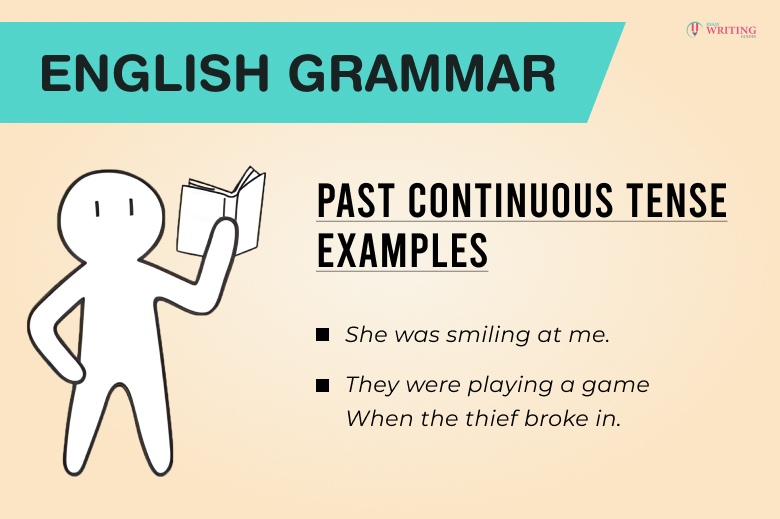“It was 21st October of 1937. The war had ended and the enemy troops left our land after spilling the bloods of our own on our green grass. I was hiding for past few months, and this is the first letter I was writing to my wife.”
Can you spot the past continuous tense in the passage above? Yes, you should look for the past form of the ‘to be’ and (-ing) added to the main verb. The present and past continuous tense are quite easy to learn and use in a sentence.
However, if you are having trouble, this article can be an easy guide to help you learn past progressive or continuous tense. So, what’s the wait? Let’s learn.
What Is Past Continuous Tense?

The verb in English grammar has three different Tenses – past, present, and Future tense. Each of the three different types of tenses has four different subtypes. If we take a past tense, here are the classifications of the past tense –
- Simple past tense
- Past continuous tense
- Past perfect tense &
- Past perfect continuous tense
Here, I have discussed past continuous tense and explained the past continuous tense formula.
Past continuous tense is used to describe an action that started in the past and was going on during a given time in the past until something else happened. Simply, it means the continuation of an action in the past. The past progressive tense is constructed using the past form of the “to be” verb and the present participle (-ing) form of the verb.
Sometimes storytelling in the background of a drama or a cinema uses past continuous tense. For instance –
“It was 21st October of 1937. The war had ended and the enemy troops left our land after spilling the bloods of our own on our green grass. I was hiding for past few months, and this is the first letter I was writing to my wife. She was living with my in laws at the northern part of the country. My father in law was a rich merchant and had the privilege to have the local police force guarding the family. It was the time of war, and they were living a stable life when everyone else in the country were somehow surviving. During my hiding, I met few other revolutionaries who were trying to regroup and plan an attack against the enemy.”
[Note: Past continuous tense changes when it is converted into passive voice]
So, here is a passage written like a story. You can try and find out the use of past continuous sentences from there. You can also look at the random examples I have given below –
Past Continuous Tense Examples

- They were playing a game when the thief broke in.
- I was scrolling Instagram in the classroom.
- He was working at the desk as I sat beside him.
- I was driving when the rain started.
- She was smiling at me.
- John was dancing on the roof.
- The aeroplane was landing at the airport.
- They were singing the song together.
- The dragons were burning the city.
- She was spinning the wheel of fortune.
Reading these examples should help you understand past continuous tense. But, How to form past continuous tense? Here, I have explained the formula in affirmative, negative, interrogative, and interrogative negative sentences.
Past Continuous Tense Formula

Here is the formula to construct a sentence in the past continuous tense.
Subject + was/were + present participle (verb+ing) + rest of the sentence
However, the rule changes a little bit based on whether you want to write an affirmative sentence or a negative sentence or the others.
| Sentence Type | Subject | +Was/were | +base + Ing |
| Basic | They | were | playing |
| Affirmative | He | Was | Dancing |
| Negative | She | Was not | Reading |
| Interrogative | Was | He | Laughing |
| Interrogative | Wasn’t | She | Crying |
Although the formula remains the same, the positions of ‘to be’ and the subject change. It happens when past continuous tense is used for interrogative and negative interrogative sentences.
If you want more examples, here is a chart to help you. I have offered affirmative, negative, and interrogative forms of the same sentence in this article.
| Affirmative | Negative | Interrogative |
| I was reading. | I was not reading. | Was I reading? |
| You were sleeping. | You were not sleeping. | Were you sleeping? |
| She was cooking. | She was not cooking. | Was she cooking? |
| They were working. | They were not working. | Were they working? |
Bottom Line
Once you follow the rules and go through the examples, you can easily understand and create sentences using past continuous tense. It is crucial to know tense and all the different forms of it if you want to construct grammatically correct sentences.
Did you find this article helpful? If so, please comment to let us know. You can also leave your queries in the comment; we will answer them as soon as possible.
Read Also:
- What Does WYO Mean? A Complete Guide
- What Are The 5 Letter Words With No Vowels?
- “Truely or Truly” – What is The Difference Between Truely and Truly?
